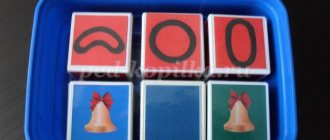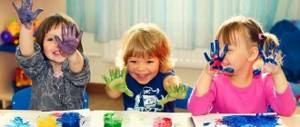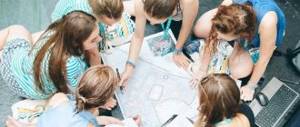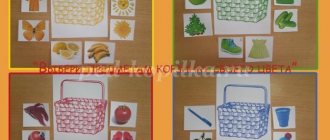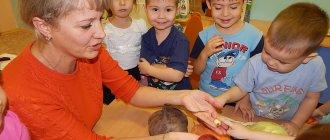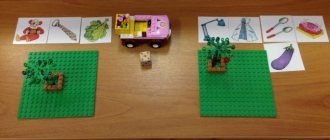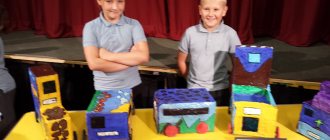Self-care lesson in the senior group of kindergarten
Children 5–6 years old have well-developed fine motor skills and coordination of movements. They master the skill of dressing and undressing, and remember the sequence of actions. Children are familiar with the rules of personal hygiene. While eating, older preschoolers skillfully handle cutlery. At this age, more attention should be paid to the rules of behavior at the table, strengthening the skill of monitoring one’s appearance, the condition of the working and sleeping space.
At older preschool age, children understand the teacher's instructions and follow verbal instructions. Self-care is recognized by methodological research as the simplest and at the same time one of the main elements of a child’s work activity. Examples of work assignments for self-service: “Pull away the dishes and tidy up the table”, “Please turn your turtleneck inside out and hang it up to dry”, “Vova, your shoelace is untied, sit on the bench and tie a bow”, “Katya, in front of During the dance class, you need to tie your hair up with an elastic band/braid it.” The first self-service instructions should be presented visually, for example, in the form of mnemonic cards - a sequence of pictures on a specific topic.
In the older group, you can draw up a duty schedule in order to develop in the children the ability to set the table, monitor order and cleanliness in the dining and play areas, bedroom, and locker room. Positive emotions come from being on duty in a corner of wildlife, where the children are tasked with monitoring the condition of animals and plants and caring for them.
The children enjoy watching plants and animals and carrying out tasks to care for them.
Card index of topics on developing self-service skills: table
| Self-Care Topic | Educational and training tasks | Techniques for independent activities of children |
| "Eating" | Strengthening the skills of cultural eating and handling cutlery. Cultivating a sense of neatness: take garbage to a specially designated place, check the cleanliness of the table after finishing the meal. Conscientiously perform the duties of cafeteria attendants. | Games with doll dishes and toys, didactic games for learning the rules of cultural eating, carrying out work assignments while on duty. |
| "Dressing and Undressing" | Generalization and consolidation of the skills of consistent dressing and undressing, neat hanging and folding of removed items. Improving the ability to cope with different types of fasteners and laces. | Games for fine motor skills with fasteners, didactic games for memorizing the algorithm for the correct sequence of actions when dressing/undressing, games with doll clothes. |
| "Rules of personal hygiene" | Strengthening cultural and hygienic skills: using the bathroom and toilet, washbasin, handkerchief. Consolidation of dental care skills (teeth brushing algorithm, use of dental floss). | Conducting conversations about the importance of maintaining hygiene rules, the need to take care of your body, conducting training games like “Teach your baby how...”. |
| “Keeping shoes and clothes, sleeping place, work tools, etc. in order.” | Improving the skill of noticing and independently eliminating disorder in your appearance (correcting your hair, clothes, cleaning your shoes in a timely manner). Consolidating the skill of making the bed, keeping the bed clean and tidy. Fostering a caring attitude towards things: items of clothing and shoes, accessories, work tools (pencils, brushes, outdoor equipment), toys, books. Involvement in general cleaning of the premises. | Conducting game trainings “Hairstyles”, “Describe how a friend is dressed”, didactic games “Name what is wrong in the character’s appearance”, “What is out of place”, competitions for the neatest workplace/locker. |
Older preschoolers need to be taught to conscientiously perform the duties of the duty officer
Summary of a self-care lesson in the senior group on the topic “Water is our good friend”: table
| Goals | 1. To consolidate children’s knowledge about the rules of personal hygiene (hand care). 2. Consolidate knowledge about hand skin care products. 3. Consolidate knowledge about the hand washing algorithm. 4. Introduce children to the three “golden” rules for hand care: wash hands after using the toilet, after a walk, before eating. 5. Activate and enrich children’s vocabulary through the use of nursery rhymes, poems, words: transparent, clean, calm. 6. Strengthen the skills of differentiating mouth and nasal breathing (game “It’s time to get up”). 7. Develop communication skills. |
| Preliminary work | 1. Introduction to hand care products. 2. Introducing and reviewing the algorithm and the “Three “golden” rules.” 3. Observations in nature of rain and snow. 4. Conducting experiments with snow, experiments confirming the moisture needs of plants. 5. Work on onomatopoeia: the song of the water - s-s-s; rain - drip-drip-drip. 6. Carrying out breathing exercises. 7. Learning nursery rhymes about water. 8. Speech games: “What kind of water?”, “What is water for?” 9. Sensory games to develop thermal sensations: “What kind of water?” 10. Games with water: “Get the toy with a spoon, strainer”; “Find out what it is?” (with eyes closed). 11. Reading fiction: V. Mayakovsky. "What is good and what is bad?"; A. Barto. “Greasy girl”; K. Chukovsky. "Moidodyr". |
| Material | Hand washing items; strainer, spatula, watering can, bucket of water; doll, bunny and other toys; algorithm and “Three “golden” rules”. |
| Progress of the event | Organizing time. The teacher enters the group with the children. Children sit on chairs (“sleep”). Game “It’s time to get up” Teacher (speaks in a whisper). - My children, my children, My children are fast asleep. My children, my children are quietly sniffling. Like this! The teacher takes a noisy breath in through his nose, then exhales through his mouth with the sound ho-o-o-o. Children imitate. Educator (loudly). - Sun is up! Stop sleeping! Stop sleeping! It's time to get up! Children “wake up” and, standing on their toes with their arms raised, take a breath. Then, throwing your arms along your body and lowering yourself onto your full foot, exhale. Educator. - Oh, we woke up! Smile! Hello! (drawn out) Children. - Sun is up! Stop sleeping! Stop sleeping! It's time to get up! Hello! (lingering) Game “Who knows how to wash clean?” Educator. - Today we are going to visit our toys. Let's see if they can be friends with water. We know that... You must wash yourself in the morning, in the evening and during the day, before every meal, after sleep and before going to bed. Knock, knock, who lives here? (Doll Sima!) Life is unbearable for the slob Sima: The doll Sima walks around, Always in a dirty dress, Little brother Mishka is wearing dirty pants, Here is a stocking, and there is a shoe. Is it possible to do this? - Children, which of you knows how to wash yourself? Let's show the toys how to wash themselves properly. The game is accompanied by the movements indicated in the text. Who knows how to wash clean? Who isn't afraid of water? This is us! This is us! This is us! Children raise their hands up. Who doesn't want to be dirty? Wash your ears properly? This is us! This is us! This is us! Children raise their hands up. We know how to wash ourselves. We wash our necks with a washcloth. Like this! Like this! And just like that! Children pretend to rub their neck with a washcloth. And then we’ll wash the head deftly over the basin. Like this! Like this! And just like that! Children pretend to wash their hair. To wash the legs clean, We will wash them a little. Like this! Like this! And just like that! Children pretend to wash their feet. We washed ourselves like big boys, so clean we are. Look! Look! Look! Children clap their hands. 4. Consolidating children’s knowledge about the rules of personal hygiene. -Who lives here? (Bunny.) How white he is, and how clean he is, look: The bunny is washing his face - Getting ready for the kids: He washed his nose, washed his tail. I washed my ear and dried it. “And now we’ll teach Sima how to wash herself.” Let him take an example from the bunny. Sima, wash your face and neck thoroughly with soap, don’t spill the water, wipe your hands dry. - Look, guys, our Sima: She combed her hair and washed her face, bowed to all the kids, she wanted to have fun and dance again. Well, guys, come out. Dance with Sima. Children performing the dance “Ay-da, kids...”. Game "Find the necessary objects." — Guys, find the items necessary for washing your hands. Children are offered the following items to choose from: a strainer, a spatula, a watering can, a bucket of water, a towel, and soap. - To always be clean, People all need water! - What kind of water is in the bucket? (Transparent, clean, calm). - Guys, what is this? White foam flew in flakes, - Mila took the Fragrant... (soap) in her hands. - Children, look at this fragrant soap. Why do we need soap? - And what's that? Soft, fluffy, Clean - clean. We wipe our hands on it and put it back in its place. (Towel). — Why do we need a towel? 7. Consolidating children’s knowledge about the hand washing algorithm. - Guys, I suggest you make friends with some water - wash your hands. —Where will we wash our hands? (In the washroom, under the tap). Reading "The Wash Song". Silvery water flows from the tap. And there is fragrant soap, just like at home in our bathroom. - Silver water, how did you get here? — I ran through dewy meadows to kindergarten. - Silvery water, why did you run to us? - May you all be clean, May everything sparkle! A. Abelyan - Children, what kind of water flows from the tap? (Clean, transparent, gurgling). - How does the water gurgle? What song is she singing? (Ssssssss...) Reading a nursery rhyme while washing hands: Ay, okay, okay, okay, We are not afraid of water, We wash ourselves clean, We smile at all the children! Clean water will wash Lena’s face, Lida’s palms, Antoshka’s fingers! — We washed our hands with soap. Did you forget to wipe them? - How are we going to wipe our hands? (Use a fluffy, soft towel). Reading a nursery rhyme while wiping your hands: One, two, three, four, five! We'll wipe our hands. Your fingers will become dry - Like this, like this! - Well done, guys! Your hands are clean - that means everything is in order! 8. Low mobility game “Round Dance”. Children form a circle and hold hands. The teacher, together with the children, begins to move in a circle while reading the text. Let's take our friends by the hands and start our round dance. We tried, washed, dried, combed our hair. And now lunch awaits us: Borscht, compote and vinaigrette. Now everyone will go to bed on a cozy bed. Children stop, put their hands under their cheeks, palm on palm (“fall asleep”). 9. Summary of the lesson. - Well done, guys! I am very happy for you that you know so many useful things. When you come home in the evening, tell moms and dads about your good friend - water, don’t forget to show how you know how to wash and wipe your hands clean. |
Algorithms for the sequence of self-care actions should hang in the toilet room, bedroom, locker room, dining room
Self-care lesson time plan: table
Educational and training tasks of forming and consolidating self-service skills are implemented in ECD classes, the duration of which in the senior group is no more than 20 minutes. Educational classes have a structure consisting of various forms of work to attract the interest of students and prevent fatigue.
| Lesson topic | Organizing time | Motivating start | Development of thinking abilities | Physical activity | Independent activity | Summarizing |
| "Parsley doesn't know how to clean" | 1 minute | Creating a problematic situation. The character Petrushka comes to the group and reports that he was suspended from the art club because he did not take care of his work place. Parsley asks the guys for help. 2–3 minutes | A conversation about the importance of maintaining cleanliness. 3 minutes | Outdoor game "Parsley on the bench." 4 minutes | Putting things in order in the art workshop. 10–12 minutes | 2 minutes |
| “Everything in a person should be beautiful” | 2 minutes | Surprise moment. The group receives a package by mail from the director of the puppet theater. He put the dolls in a box so that the guys could help him put them in order. 3 minutes | A conversation about a person’s appearance, when an appearance attracts the eye, and when it repels. 4 minutes | Finger gymnastics about dolls. 3 minutes | Playful activity of dressing up and combing dolls' hair. 10–12 minutes | 2 minutes |
Independence is demonstrated by older preschoolers in all areas of the educational process. The teacher’s task is to be extremely attentive to the activities of students, identify difficulties in independent work and timely correction. Having positive motivation to do research, play games and create crafts without the help of an adult is an important component of the personality of a future first-grader.
Organization of independent activities of preschool children in accordance with the Federal State Educational Standard
In accordance with the Federal State Educational Standard, educational tasks must be solved
- during regime moments,
in the joint activities of children with the teacher (including in the classroom),
- in children’s independent activities
- in joint activities with the family.
One of the main forms in the process of education and upbringing of children in kindergarten is the independent activity of children.
Independent activity of children is one of the main models for organizing the educational process of preschool children:
1) free activity of pupils in the conditions of a subject-specific developmental educational environment created by teachers, ensuring that each child chooses an activity based on his interests and allows him to interact with peers or act individually;
2) activities of pupils organized by the teacher, aimed at solving problems related to the interests of other people (the emotional well-being of other people, helping others in everyday life, etc.).
The scheme for the development of any type of activity in accordance with the concept of L. S. Vygotsky is as follows: first it is carried out in joint activities with adults, then in joint activities with peers and, finally, it becomes an independent activity of the child. In this case, a special role is assigned to the teacher.
The teacher must create a diverse gaming environment (we are talking about a subject-developmental environment in a preschool educational institution), which should provide the child with cognitive activity, must correspond to his interests and be developmental in nature. The environment should provide children with the opportunity to act individually or together with peers, without imposing mandatory joint activities.
The teacher can get involved in the activities of children in cases of conflict situations that require the intervention of an adult, or, if necessary, help a particular child join a peer group.
The subject-development environment should be organized in such a way that every child has the opportunity to do what he loves. Such an environment must meet the individual and age characteristics of children and their leading activity - play.
At the same time, it should contribute to the development of creative abilities, awaken imagination, activity, teach communication, and vividly express one’s feelings.
Play in kindergarten should be organized, firstly, as a joint game between the teacher and the children, where the adult acts as a playing partner and at the same time as a carrier of the specific “language” of the game. The natural emotional behavior of the teacher, who accepts any children’s plans, guarantees freedom and ease, the child’s enjoyment of the game, and contributes to the desire in children to master the methods of play themselves. Secondly, at all age stages, play should be preserved as a free independent activity of children, where they use all the play tools available to them, freely unite and interact with each other, where the world of childhood is ensured to a certain extent, independent of adults.
Along with play, free productive activity of children (constructive, visual, etc.) occupies a significant place in a child’s life. Just like in play, the child’s development opportunities are enriched here.
In order to organize independent artistic activity, a child must have developed artistic experience, which the child acquires in classes. Systematic training allows you to gradually accumulate and increase the volume of skills and abilities, and already on your own initiative, children can express themselves in various types of artistic activities: musical, artistic and speech, visual, theatrical and gaming.
First of all, I structure teaching in art classes in such a way that children act not only according to direct instructions and my demonstration, but also without help. If a child learns to independently complete educational tasks, then he will be able to act in the same way outside of class: organize dramatization games, sing at his own request, and draw.
In class, the teacher shows how a fairy tale can be presented in different ways. First, the children listen to it, then look at the illustrations and use them to make up a fairy tale, then they stage it in a tabletop theater or sketch the characters and use figures to display them on a flannelgraph. Subsequently, they use these techniques completely independently - in their free time, they look at illustrations, retell fairy tales, and dramatize them. Books, pictures, homemade books, and children's works on literary subjects are of great importance in the group.
Children have a sufficient number of books at their disposal (in the children's bookcase). Along with books, there are several thematic folders with pictures, photographs, children's drawings and albums for children to look at freely. In order to interest each child in my work, I use various forms of work with children in the book corner, which I plan daily on a calendar-thematic basis (reading, looking at and discussing books, participating in the analysis and systematization of books and pictures, repairing, etc.) .
Once a month I organize a book exhibition in the group. It is advisable to devote the first one - at the beginning of the school year - to the children’s favorite books. I try to ensure that every child’s desire is satisfied. Subsequent exhibitions can be thematic: books about nature, about our Motherland, about technology, fairy tales, etc. Every Thursday in our group there is an advertisement for a book that parents read to their children at home. Children bring the book to the group and tell all the children what it is about. The group also operates a center for musical and theatrical activities for theatrical games. This center contains all the necessary equipment - a screen and sets of various types of puppet theater, theatrical costumes, printed board games, musical instruments, a tape recorder. One of the most striking forms of independent artistic activity is play. It may vary depending on the content of the activity. So, children pick up little books in order to play in the library, store; made from paper, sculpted from plasticine, dough, toys to decorate the dollhouse room for family play. Sometimes I encourage the kids to come up with and draw decorative patterns for fabric. This serves as an impetus for the development of a store game in which children “buy” these fabrics.
All materials used for independent artistic activities are constantly updated and varied.
Another pedagogical condition is the influence of holidays and entertainment. The child receives a lot of impressions during the holidays from the sound of music, songs, colorful decoration of the room, costumes, and expressive intonations of the artistic word. He becomes familiar with social phenomena reflected in an artistic and figurative form, and this becomes an indirect incentive that makes him want to convey his impressions and experiences in another artistic form: drawing, play, dance. An important condition ensuring the development of children's artistic independent activity is connection with the family. Everything that a child sees and hears at home does not go unnoticed. Adults sing, dance, draw, decorate rooms, go to the theater, cinema, and watch TV. The child, observing and taking part in this, receives artistic impressions. Arriving at kindergarten, he shares them with his peers, the teacher, and expresses his attitude to what he saw in the games.
In accordance with Federal state requirements, the mathematical development of preschool children is carried out through the joint educational activities of the teacher and children, as well as through the independent cognitive and play activities of the children themselves. A preschool child, even an older one, is a playful creature, and his greatest interest is in play and play exercises. But, very often, the method of teaching elementary mathematical concepts should not only provide the simplest knowledge and skills, but also, on their basis, develop the preschooler’s thinking, imagination, ingenuity, and speed of reaction. Math should be fun and entertaining. For independent cognitive-game mathematical activity to be effective, it is necessary:
create a special subject-development environment;
offer children a complex of entertaining gaming mathematical material in independent cognitive and play activities;
use special techniques for guiding independent cognitive and gaming mathematical activities.
The effectiveness of independent cognitive-game mathematical activity can be tracked by:
- level of children's independence;
- cognitive activity of children;
- level of motivation.
To organize children's activities, a variety of educational games, didactic aids, and materials were used to “train” children in establishing relationships and dependencies. The relationship between gaming and cognitive motives in preschool age determines that the process of cognition will be most successful in situations that require children’s intelligence. In kindergarten, in the morning and evening, there were games of mathematical content, board-printed, such as: “Domino of figures”, “Make a picture”, “Arithmetic domino”, “Logical lotto”, “Lotto”, “Find the difference” , games of checkers and chess, solving mazes and others.
The variety of entertaining material allowed each of the children to choose a game according to their interests. These are board and printed games, games for the development of logical thinking, leading children to master the game of checkers and chess: “Fox and Geese”, “Mill”, “Wolves and Sheep”, etc.; puzzles, logic problems and cubes; labyrinths, games for composing a whole from parts; to recreate silhouette figures from special sets of figures; movement games.
The teacher can plan in advance the independent activities of children, taking into account the topic that is relevant for a given day (or week), the goals and objectives of educational work during the day, that is, the principle of a comprehensive thematic structure of the educational process in a preschool educational institution must be implemented. The teacher “starts” from this topic when organizing children’s independent activities.
So, for example, in the senior group the theme of the week is “Dear Maslenitsa is coming...”
How can teachers organize children’s independent activities:
- The day before, in the group, organize an exhibition “Maslenitsa Doll” using demonstration material: paintings, children's drawings, newspaper clippings, children's books, rag dolls.
- Introductory conversation between the teacher and children on the topic.
The purpose of both exhibitions and conversations: to motivate children to study independently, to review demonstration material.
- Add materials of various properties for artistic creativity (pencils, brushes, paints, wax crayons, paper for appliqués). Using the pedagogical method of advance payment (i.e., praising the child in advance, making him believe in himself), the teacher motivates children for independent artistic creativity (appliqués “Sun”, drawings “Maslenitsa Doll”, etc.)
- During the walk, tell the children about the rules of the outdoor holiday game (which is played on Maslenitsa): a goat walked through the forest, a freckle - spring, cold - hot. And invite them to play them themselves, as well as tell other children about the games and play together.
- Children, if they wish, take pre-made “Sun” crafts and through these crafts the teacher can encourage round dance games. (The role of the teacher is to guide, the children do the rest themselves)
- In the “Housewife” corner, invite the children to bake pancakes (after reading fiction, chants and poems about pancakes), s.r.i. "Culinaries"
Thus, the teacher should devote a large amount of time during the day to organizing the independent activities of children in preschool educational institutions. And if in joint activities with children the teacher is an equal partner, then in independent activities the teacher is only an observer.
In conclusion, I would like to note that thanks to the transition to a new form of calendar planning, the organization of independent activities is clearly reflected and intersects (integrates) with other forms of work during the day (walking, routine moments, group - subgroup, joint activities). But in comprehensive thematic planning of preschool educational institutions, there is no emphasis on the independent activities of pupils; this activity is not separately prescribed, but only implied. Consequently, the following question remains open: the inclusion of the section on organizing independent activities in the comprehensive thematic planning of preschool educational institutions.
Thus, the independent work of children in a preschool educational institution is work that is carried out without the direct participation of the teacher, on his instructions, in the time specially provided for this, while the child consciously strives to achieve the goal, using his efforts and expressing in one form or another the result of mental or physical actions
Literature:
- https://xn--318–5cddaazbi7f4befi.xn--p1ai/files/fgos_fgt.pdf
- https://svet.edusluda.ru/index.php/metodicheskaya-masterskaya/24-obrazovatelnaya-deyatelnost/159-opyt-raboty-na-temu-organizatsiya-predmetno-razvivayushchej-sredy-dou-v-sootvetstvii-s- fgos-do
- https://infourok.ru/organizaciya-neposredstvenno-obrazovatelnoy-deyatelnosti-nod-v-sootvetstvii-s-fgos-do-796858.html
